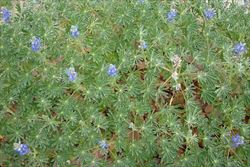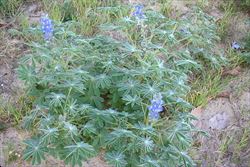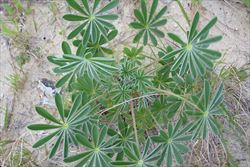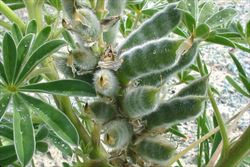Click on images to enlarge

dense infestation (Photo: Sheldon Navie)

habit (Photo: Sheldon Navie)

leaves (Photo: Sheldon Navie)

flower cluster (Photo: Sheldon Navie)

close-up of very hairy young fruit (Photo: Sheldon Navie)

immature fruit (Photo: Sheldon Navie)

mixed infestation of sandplain lupin, Lupinus cosentinii, and white lupin, Lupinus albus (Photo: Sheldon Navie)
Scientific Name
Lupinus cosentinii Guss.
Synonyms
Lupinus digitatus Forssk. (misapplied)Lupinus hirsutus L. (misapplied)Lupinus pilosus L. (misapplied)Lupinus varius L. (misapplied)
Family
Fabaceae (Queensland, the ACT, Victoria, Tasmania, and the Northern Territory)Fabaceae: sub-family Faboideae (New South Wales)Leguminosae (South Australia)Papilionaceae (Western Australia)
Common Names
blue lupin, lupin, sand plain lupin, sandplain lupin, sandplain lupine, Western Australian blue lupin, WA blue lupin
Origin
Native to north-western Africa (i.e. Morocco and Tunisia) and south-western Europe (i.e. Sardinia, Sicily, Corsica, southern Portugal and south-western Spain).
Cultivation
Widely cultivated as a fodder and grain crop in the temperate regions of Australia.
Naturalised Distribution
Naturalised in many parts of southern and eastern Australia (i.e. in south-eastern Queensland, in the coastal districts of northern and central New South Wales, in south-eastern and southern South Australia and in the south-western and western parts of Western Australia). Also naturalised on Norfolk Island.
Habitat
A common weed of disturbed sites, waste areas, roadsides, parks, cropping areas, open woodlands, waterways and coastal environs in the temperate regions of Australia (occasionally also found in semi-arid and sub-tropical regions).
Habit
A large, upright (i.e. erect), short-lived (i.e. annual), herbaceous plant usually growing 0.2-1.2 m tall, but occasionally reaching up to 1.4 m in height.
Distinguishing Features
- a large, upright, short-lived herbaceous plant usually growing 0.2-1.2 m tall.
- its stems are much-branched and densely covered in short whitish hairs.
- its leaves are compound with 7-13 leaflets that all radiate from the same point like the fingers of a hand.
- its pea-shaped flowers (12-17 mm long) are arranged in elongated clusters (5-15 cm long) at the tips of the branches.
- these flowers are mostly blue in colour, though their uppermost petals often have a whitish or yellowish base.
- its elongated pods (4-6 cm long and 1.3-1.7 cm wide) are densely hairy and usually contain 3-5 seeds.
Stems and Leaves
The stems are much-branched and densely covered in short whitish hairs (i.e. pubescent or shortly villous) about 1 mm long. Younger stems are greenish in colour while older stems towards the base of the plant may become somewhat woody in nature.
The alternately arranged leaves are compound with 7-13 leaflets, which all radiate from the same point like the fingers of a hand (i.e. they are palmately compound). These leaves (usually 15.5-21.5 cm long) are borne on velvety hairy stalks (i.e. pubescent petioles) 3-15 cm long. The leaflets (1.8-7 cm long and 5-16 mm wide) are elongated in shape (i.e. oblanceolate to oblong) with tapered (i.e. attenuate) bases and shortly pointed tips (i.e. mucronate apices). Their surfaces are silky hairy (i.e. pubescent), particularly their undersides, and their margins are entire.
Flowers and Fruit
The numerous flowers are arranged in elongated clusters at the tips of the branches (i.e. in terminal racemes). These clusters (5-15 cm long) are borne on short stout stalks (i.e. peduncles) about 3 cm long. Individual flowers are arranged in groups (i.e. whorls) along the main stem of the flower clusters and are borne on very short stalks (i.e. pedicels) 2-4.5 mm long. These pea-shaped flowers (12-17 mm long) are mostly blue in colour, though the uppermost petal (i.e. standard) in each flower often has a whitish or yellowish base. They also have two side (i.e. lateral) petals and two lower petals that are fused together into a single folded petal (i.e. keel) with a whitish base. The five green sepals (8-12 mm long) are hairy (i.e. villous) and fused together at the base into a short tube (i.e. calyx tube). Each flower also has ten stamens, with their filaments being fused together into a tube, and an ovary topped with a style and stigma. Flowering occurs mostly during spring (i.e. from August to November).
The elongated pods (4-6 cm long and 1.3-1.7 cm wide) are densely hairy (i.e. villous or pubescent) and usually contain 3-5 seeds. They are somewhat flattened (i.e. compressed) and turn from greenish to brownish in colour as they mature. The seeds are almost circular and somewhat flattened (6-9 mm long, 4-7 mm wide and 3-4 mm tall) with rough surfaces. They are light grey, greyish-brown or brown with darker brown or blackish coloured markings (i.e. mottled).
Reproduction and Dispersal
This species reproduces only by seed.
The seeds are often dispersed to new areas during the transport of this species as a grain and fodder crop. They may also be spread in water and contaminated soil.
Environmental Impact
Sandplain lupin (Lupinus cosentinii) is a significant environmental weed in Western Australia, but is not regarded as a serious problem in other parts of Australia. It has the ability to invade undisturbed bushland and can change the structure, composition and function of natural ecosystems. For these reasons it was recently ranked as a highly invasive species in the Environmental Weed Strategy for Western Australia.
Sandplain lupin (Lupinus cosentinii) is a widespread and serious weed of roadsides, woodlands, heathlands, river edges, swamps, lake margins and disturbed natural vegetation from Carnarvon to Esperance in Western Australia. It is also becoming widespread in South Australia and is present in conservation areas in both of these states (i.e. Blackwall Reach Reserve and Point Walter Bushland in Western Australia and Aldinga Scrub Conservation Park in South Australia).
Legislation
Not declared or considered noxious by any state government authorities.
Similar Species
Sandplain lupin (Lupinus cosentinii) is very similar to several other lupins, all of which are introduced into Australia and some of which are also environmental weeds. The most common of these are narrow-leaved blue lupin (Lupinus angustifolius), white lupin (Lupinus albus), tree lupin (Lupinus arboreus), yellow lupin (Lupinus luteus) and Russell lupin (Lupinus polyphyllus). These species can be distinguished by the following differences:
- sandplain lupin (Lupinus cosentinii) has blue flowers and leaves with 7-13 leaflets. These leaflets are relatively large (18-70 mm long and 5-16 mm wide) and both surfaces are hairy.
- narrow-leaved lupin (Lupinus angustifolius) has blue flowers and leaves with 5-9 leaflets. These leaflets are relatively small (12-35 mm long and 2-5 mm wide) and are only hairy on their undersides.
- white lupin (Lupinus albus) has white flowers and leaves with 5-11 leaflets. These leaflets are relatively large (47-60 mm long and 12-20 mm wide) and both surfaces are hairy.
- tree lupin (Lupinus arboreus) has pale yellow flowers and leaves with 5-12 leaflets. These leaflets are relatively large (25-75 mm long) and only sparsely hairy.
- yellow lupin (Lupinus luteus) has golden yellow flowers and leaves with 5-11 leaflets. These leaflets are relatively large (20-40 mm long and 8-10 mm wide) and both surfaces are hairy.
- Russell lupin (Lupinus polyphyllus) has blue, purple, pink or white flowers and leaves with 9-17 leaflets. These leaflets are large (50-150 mm long and 10-30 mm wide) and only sparsely hairy.

